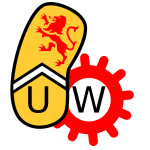Team:Waterloo
From 2008.igem.org
(Difference between revisions)
(Added team logo) |
|||
| Line 1: | Line 1: | ||
{|align="justify" | {|align="justify" | ||
|The UW iGEM team is an interdisciplinary undergraduate-driven group spanning the faculties of Science, Mathematics, and Engineering. Our undergraduate members and graduate and faculty advisors bring skills, expertise, and perspectives from a broad range of fields, including Biology, Biochemistry, Computer Science, Bioinformatics, Computer and Electrical Engineering, Chemical Engineering, and Mathematical Physics. | |The UW iGEM team is an interdisciplinary undergraduate-driven group spanning the faculties of Science, Mathematics, and Engineering. Our undergraduate members and graduate and faculty advisors bring skills, expertise, and perspectives from a broad range of fields, including Biology, Biochemistry, Computer Science, Bioinformatics, Computer and Electrical Engineering, Chemical Engineering, and Mathematical Physics. | ||
| - | |[[Image: | + | |[[Image:UWiGEMLogo.png|200px|right|frame]] |
|- | |- | ||
| | | | ||
Our goal is to engineer a genome-free, cell-based expression system capable of producing a desired protein in response to environmental signals. The genome will be degraded by the combined activity of a restriction endonuclease (to fragment the genome) and an exonuclease (to hasten degradation of the genome). The gene for the protein of interest will be located on a plasmid which will lack recognition sites for the endonuclease, enabling it to remain intact after genome degradation. Expression of plasmid genes is expected to continue for a period of time until the "cell" expires. | Our goal is to engineer a genome-free, cell-based expression system capable of producing a desired protein in response to environmental signals. The genome will be degraded by the combined activity of a restriction endonuclease (to fragment the genome) and an exonuclease (to hasten degradation of the genome). The gene for the protein of interest will be located on a plasmid which will lack recognition sites for the endonuclease, enabling it to remain intact after genome degradation. Expression of plasmid genes is expected to continue for a period of time until the "cell" expires. | ||
| - | |[[Image: | + | |[[Image:teampicture.png|right|frame|Your team picture]] |
|- | |- | ||
| | | | ||
Revision as of 02:01, 11 July 2008
| The UW iGEM team is an interdisciplinary undergraduate-driven group spanning the faculties of Science, Mathematics, and Engineering. Our undergraduate members and graduate and faculty advisors bring skills, expertise, and perspectives from a broad range of fields, including Biology, Biochemistry, Computer Science, Bioinformatics, Computer and Electrical Engineering, Chemical Engineering, and Mathematical Physics. | |
|
Our goal is to engineer a genome-free, cell-based expression system capable of producing a desired protein in response to environmental signals. The genome will be degraded by the combined activity of a restriction endonuclease (to fragment the genome) and an exonuclease (to hasten degradation of the genome). The gene for the protein of interest will be located on a plasmid which will lack recognition sites for the endonuclease, enabling it to remain intact after genome degradation. Expression of plasmid genes is expected to continue for a period of time until the "cell" expires. | File:Teampicture.png Your team picture |
| Team Example 2 |
| Home | The Team | The Project | Parts Submitted to the Registry | Modeling | Notebook |
|---|
(Or you can choose different headings. But you must have a team page, a project page, and a notebook page.)
 "
"
